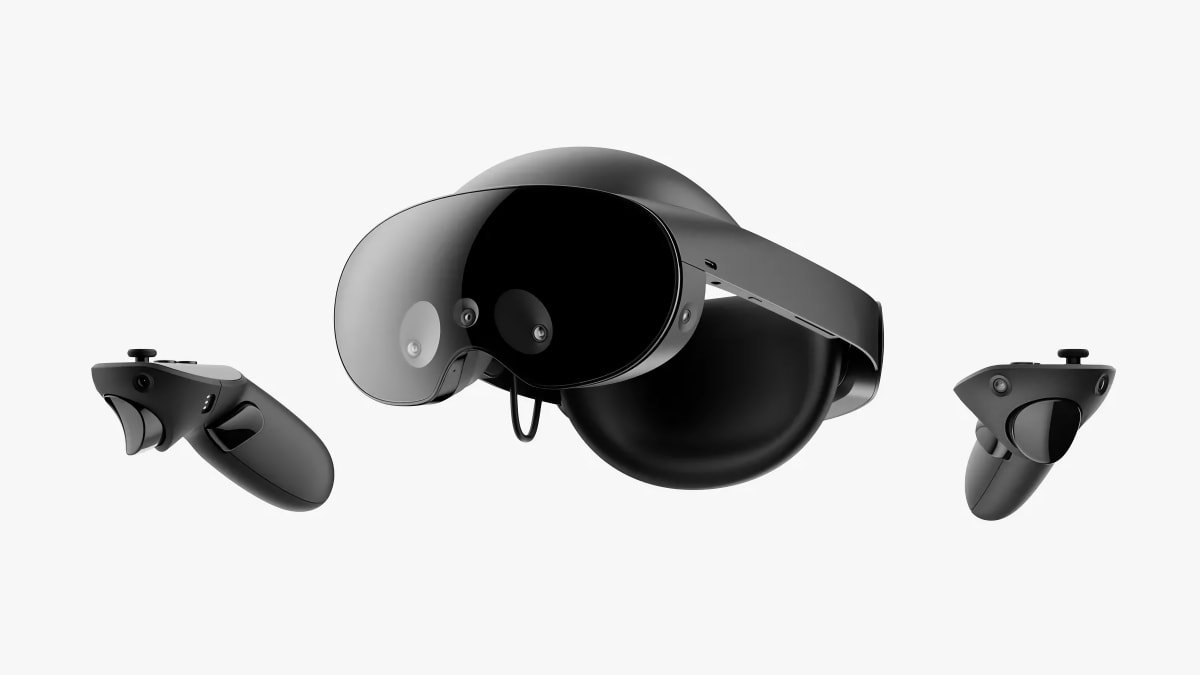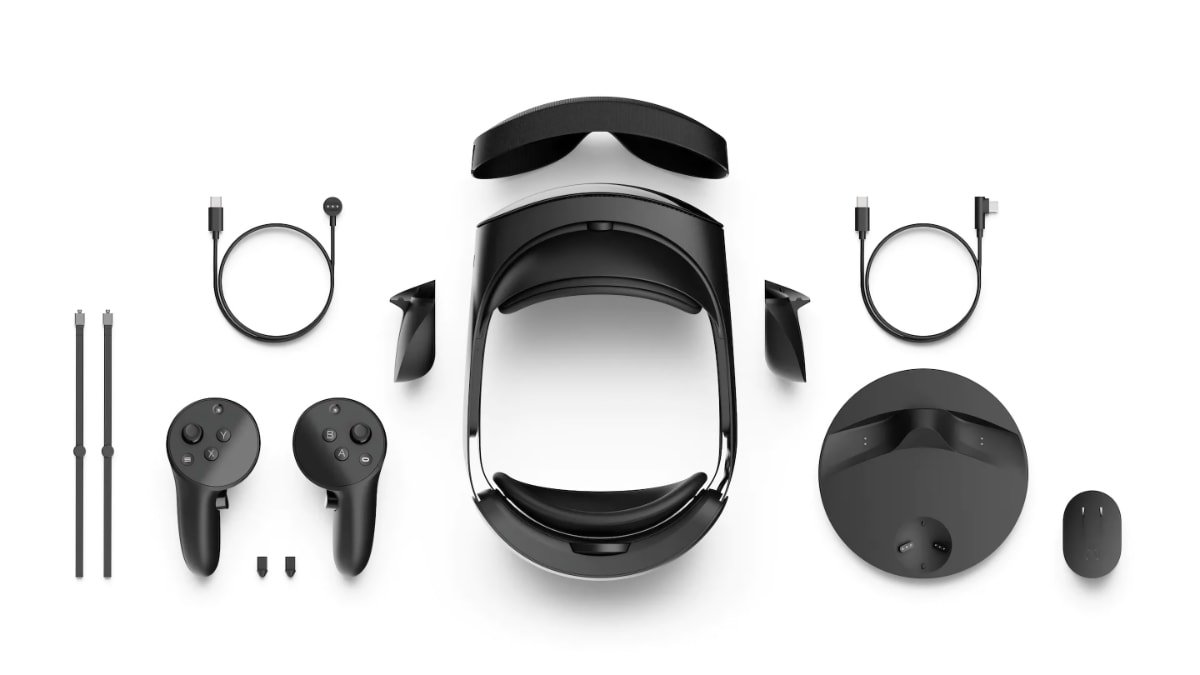Quest Pro is Meta's new $1,499 mixed reality headset
Meta announced the Quest Pro virtual reality headset at its Meta Connect 2022 conference, with it aimed at enterprise and the professional market.

Meta's Quest Pro headset
The company will offer Quest Pro alongside its already-existing, and more affordable $399 Quest 2 device. Meta says that the new Quest Pro targets professionals and those in enterprise for whom a higher price tag may be justifiable.
Formerly known as Project Cambria, the Quest Pro is thinner than the Quest 2. It fits onto a person's head using a padded plastic ring, and the battery has been moved to the rear for better balance.
The new "pancake" lenses are 40% thinner than the Quest 2, and the company says its optics technology "folds light" inside the optical module.
The Quest Pro uses full-color pass-through from four high-resolution cameras on the headset to capture and display a person's surroundings while they wear the device. The Quest 2 only has a black-and-white version of this technology.
The feature should help it capture "mixed reality" experiences that overlay digital content onto the environment instead of being limited to virtual reality.
Unlike the Quest 2, the Quest Pro has eye-tracking technology through inward-facing cameras. The company says they will help detect if the headset is fitted correctly and enable facial expressions with Meta avatars.
The headset uses a Snapdragon XR2+ chipset with an 1800 x 1920 LCD panel for each eye, four times higher than the Quest 2. Meta says these displays offer 75% more contrast and 10% more pixels per degree of sight than the Quest 2.

Accessories include chargers, controllers, a charging dock, and face masks
The company also says the chip delivers 50% more power than the XR2 chip in the Quest 2. The Quest Pro has 12 GB of RAM and 256GB of storage, 12 sensors for virtual reality and mixed reality, and spatial audio.
The increased power has a downside. Meta says the Quest Pro will only get one to two hours of battery life instead of the two- to three-hour life that the Quest 2 achieved.
Redesigned controllers for the new headset omit the tracking rings of the Quest 2, using onboard cameras that track each controller's position relative to the Quest Pro headset. Each controller has a Qualcomm Snapdragon 662 mobile processor.
Meta sells the Quest Pro through its Meta Store for $1,499, along with retail partners in four countries. It's immediately available to preorder through Meta.
Best Buy and Amazon will sell the product in the US and Canada; Amazon, Argos, and Currys will offer it in the UK; and Amazon, Fnac, and Boulanger will offer the Quest Pro in France. Prices vary by market.
Read on AppleInsider

Comments
Imagine working in a data centre and trying to quickly locate a disk/PSU that needs replacing. With MR it would be flagged on the headset so that you go right to the effected part because you would 'see' it in real time.
In fact this usage is fairly common right now with mixed reality headsets.
I can think of lots of other areas where it will be useful. Imagine manufacturing for example. Farming. Ports. Logistics....
This is quite old (things have come a long way since) but it's a quick and dirty example of what can be done
I tried the Quest 2 and it was clunky and an eye strain to use. 10% more pixels per degree of visibility isn't enough of an improvement IMHO. Not to mention the tracking, mining and sharing of personal information and the general untrustworthiness Meta is known for.
Yes, gaming. But also gaming with others in a virtual space (see Playroom). But also painting and sculpting things you can literally move around and through, creating whole experiences to share with others (see Dreams), films where you are literally in the scene and can look inside, around, under objects and rooms. Simulations. Virtual meetings and collaboration spaces. Also, I feel like people dismiss gaming in VR as if it’s anything like flat gaming. It isn’t. You are IN the game.
Many VR games great exercise. Some are built specifically to exercise, some give you exercise as a side effect. Workouts comparable to going to the gym, dripping with sweat when you're done. But a lot more fun than going to the gym.
Standing up and moving your body as the controller is far more natural than using a controller in a traditional gaming system.
Multiplayer games give you the feeling that you're in the same room with the other person even if you're in different states of countries. The ping pong game Eleven feels like you're playing ping pong with someone in the same room, using all of the same movements as you would at a real ping ping table.
A lot of what Meta is building brings that same sense of being in the same place to business meetings, far mere immersive than things like Zoom. Including shared white boards to collaborate is if you're in the same room.
A big thing with Quest Pro is to improve the immersion by improving the avatars, including eye/face tracking to bring the actual expressions to the avatars. Part of what they demoed for the future is making the avatars look just like the person.
Another big thing with Quest Pro is mixed reality, so the real world and can VR blend together.
I have spent thousands of hours playing VR over the last 4 1/2 years. Quest 2 is my favorite one to play because of the lack of cables.
Apple needs to get their VR out soon. They are spending way, way too much time getting a product out. As Steve Jobs said, "real artists ship." I'm really surprised they are taking so long since fitness is such a big push in their ecosystem.
It is baseball/softball training and you get feedback from experts.
If we can assume that the iPhone 14 Pro has the computing power necessary, and that's priced at US$1099 with the same storage but half the RAM of the Quest Pro, and you add AirPods Pro at US$249 for the spatial audio then we're at US$1348. Subtract the cost of the phone screen, add the cost of the headset, visor and extra RAM... yeah, US$1499 sounds like a good ballpark. Maybe higher if you want the AirPods Max experience.
Apple's silicon is years ahead of anything else out there. The drawbacks of the Quest Pro are battery life and weight, and Apple's likely to have a handy lead in those areas. If you're only using the headset for virtual meetings (and Ben Thompson seems to think that's one of the primary use cases) then having to recharge after two hours could be acceptable, unless you're a manager whose days are absolutely filled with back-to-back meetings (in which case, buy two). And weight might be less of a problem if you're sitting down, although I remain skeptical.